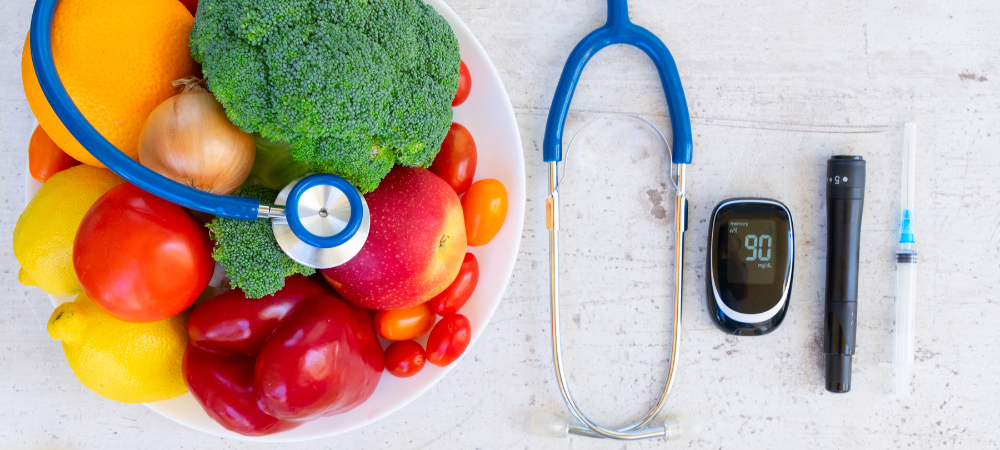
By Kayla Colgrove, MS, RDN, ACSM-CPT, Extension Educator in Lancaster County
Did you know 38 million people have diabetes in the United States, and 1 in 5 of them don’t know they have it? November is American Diabetes Month, a time dedicated to raising awareness about diabetes.
TYPES
Diabetes is a long-lasting health condition that affects how your body turns food into energy. Type 1, Type 2 and gestational diabetes are the three main types of diabetes.
Type 1 diabetes occurs when the body doesn’t make enough insulin, so people need to take insulin every day. It can develop at any age, but is usually diagnosed in children and young adults.
Type 2 diabetes is the most common type. It is known as insulin resistance, which means the body can’t use insulin properly. This type most often develops in people 45 or older, but is increasing in children, teens and young adults. Making lifestyle changes can help prevent or delay type 2 diabetes.
Gestational diabetes develops around the 24th week of pregnancy in pregnant women who have never had diabetes. It could put the baby at a higher risk for health problems. Testing for it between 24 and 28 weeks is important since most people do not have symptoms.
PREVENTION
More than 1 in 3 adults have prediabetes but over 80% are unaware of their condition. Prediabetes is when blood sugar levels are higher than normal but not high enough to be diagnosed with type 2 diabetes. This condition increases the risk of developing type 2 diabetes, heart disease and stroke. Fortunately, both prediabetes and type 2 diabetes can be prevented through lifestyle changes.
It is important to catch prediabetes early to help prevent or delay type 2 diabetes. A blood sugar test is a simple and quick way to find out if you have prediabetes. Talk to your doctor about getting your blood sugar tested if you have any risk factors for prediabetes, such as:
• Being overweight
• Being 45 years or older
• Having a parent, brother or sister with type 2 diabetes
• Being physically active less than three times a week
• Ever having gestational diabetes (diabetes during pregnancy)
• Giving birth to a baby who weighed more than 9 pounds
• Having polycystic ovary syndrome.
SIMPLE TIPS FOR BETTER HEALTH
Lifestyle changes such as making healthy eating choices, getting more physically active and losing a small amount of weight are proven to prevent or delay type 2 diabetes. Set small goals that work for you.
Make Healthy Food Choices. Start building a healthier plate by eating a variety of foods. Fruits, vegetables, whole grains, protein foods and fat-free or low-fat dairy or fortified soy alternatives are healthy choices. Include a variety of protein foods such as seafood, lean meats, poultry, beans, peas, lentils, nuts and eggs.
Read food labels to help increase your dietary fiber, calcium and vitamin D, and decrease added sugars, saturated fat and sodium. Drink water instead of sugar-sweetened beverages. Regular soda, energy or sports drinks and other sweetened drinks usually contain a lot of added sugars. Get the My Plate Plan at myplate.gov/myplate-plan to find out what is right just for you.
Move More. It is never too late to focus on moving more and sitting less throughout the day. Always remember some activity is better than none. Walking, biking, gardening or playing sports are a few examples of how you can be active. Aim to get 30 minutes of physical activity 5 days a week. Start gradually and increase the amount and intensity of physical activity over time. Use the Move Your Way Activity Planner at health.gov/moveyourway/activity-planner to get more active. Check with your doctor before starting a physical activity routine.
Taking control of your health through these simple changes can significantly reduce your risk of diabetes and improve your overall well-being. Remember, progress doesn’t happen overnight, and every small step counts. Whether it’s choosing a healthy meal or adding an extra 10 minutes to your walk, celebrate those successes. Let’s use American Diabetes Month as a reminder to take action and prioritize our health.
Sources:
• cdc.gov/diabetes
• diabetes.org